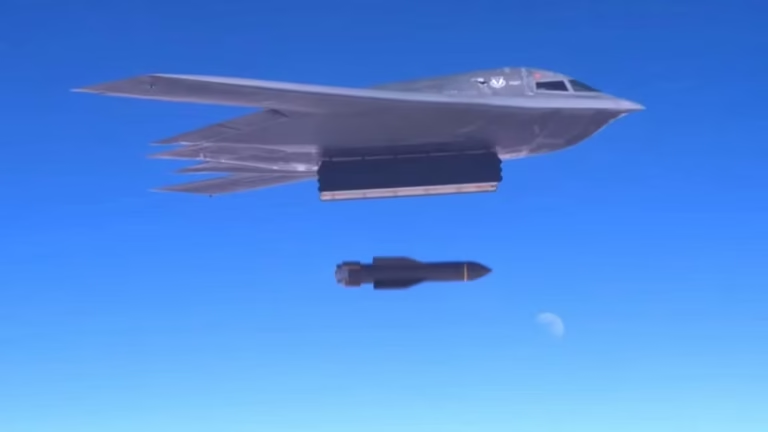The GBU-57, also known as the Massive Ordnance Penetrator (MOP), represents a significant advancement in the United States’ arsenal of precision-guided munitions designed to destroy deeply buried and fortified targets. Developed to overcome the limitations of conventional bombs, the GBU-57 carries an immense payload capable of penetrating hundreds of feet of earth and reinforced concrete before detonating. This bomb is a key strategic tool for targeting underground military and nuclear facilities that are otherwise shielded from conventional attacks.
Weighing approximately 30,000 pounds and measuring around 20 feet in length, the GBU-57 is one of the largest conventional bombs in the world. Its massive size and weight give it the kinetic energy necessary to break through layers of rock, soil, and concrete. Unlike smaller bunker-buster bombs, the GBU-57 is engineered specifically for high-value targets that are buried deep underground, such as nuclear weapons facilities, command bunkers, and hardened shelters. Its design makes it unique in the realm of modern military weaponry.
The bomb’s guidance system combines GPS technology and inertial navigation, allowing it to strike with remarkable precision despite its size. Typically, the GBU-57 is deployed by the B-2 Spirit stealth bomber, one of the few aircraft capable of carrying such a large and heavy weapon. The stealth capabilities of the B-2 also provide the advantage of penetrating enemy airspace with a lower risk of detection, increasing the chance of mission success. This combination of advanced guidance and stealth delivery makes the GBU-57 an effective and feared weapon.
Development of the GBU-57 began in the early 2000s as part of the U.S. Air Force’s efforts to modernize its bunker-busting capabilities. Boeing played a central role in manufacturing the bomb, aiming to create a weapon that could destroy targets unreachable by existing ordnance. Prior bunker-buster bombs like the BLU-109 were limited in their ability to destroy deeply buried facilities, leaving critical targets vulnerable. The introduction of the GBU-57 was a response to emerging threats and the need for enhanced precision strike capabilities against fortified underground sites.
Until recent years, the GBU-57 had not been used in combat, remaining a closely guarded asset within the U.S. military. Reports indicate that the bomb was deployed in strikes against Iranian nuclear facilities, marking its first known operational use. These strikes targeted facilities built deep underground, which were believed to be beyond the reach of previous bombing campaigns. The GBU-57’s ability to penetrate hundreds of feet below the surface made it uniquely suited for these missions.
The strategic importance of the GBU-57 lies not only in its destructive power but also in its role as a deterrent. Adversaries who rely on underground facilities for critical military operations or nuclear programs face increased risk knowing that the U.S. possesses a weapon capable of neutralizing these sites. This capability alters the strategic calculations of such nations and adds pressure to diplomatic negotiations and conflict scenarios.
Despite its conventional explosives, the GBU-57 carries significant risks when used against certain targets. For instance, striking a nuclear facility raises concerns about potential radioactive contamination. Intelligence agencies and international organizations like the International Atomic Energy Agency monitor such strikes closely to ensure there is no release of hazardous materials. The use of the GBU-57 in such contexts demands careful planning and consideration to minimize unintended consequences.
Politically, the deployment of the GBU-57 signals a willingness to escalate military actions beyond surface targets, reflecting a more aggressive stance in conflict zones. It underscores the challenges faced by policymakers when balancing the need to disable enemy capabilities while avoiding broader regional escalations. Its use can lead to heightened tensions and provoke retaliatory threats from affected nations.
In terms of operational limitations, the GBU-57’s size restricts its deployment to only a few aircraft, mainly the B-2 bomber. This limits the number of strikes that can be carried out in a short timeframe but also ensures that the bomb is used strategically and sparingly. The requirement for advanced stealth delivery also means the GBU-57 is part of specialized missions rather than routine bombing campaigns.
The Massive Ordnance Penetrator stands as a remarkable example of how military technology evolves to address complex modern threats. By enabling the destruction of heavily fortified and deeply buried targets, the GBU-57 provides the U.S. military with a significant edge in precision strike capabilities. Its presence in the arsenal is a clear message to adversaries that underground facilities are no longer safe havens from aerial attacks, reshaping the nature of modern warfare and strategic deterrence.







